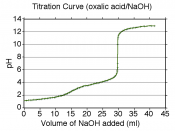AbstractWater is important substance for all living organisms. The physical and chemical properties of water play a central role in biological structure and function of the organism. The ionization ability of water to form H+ and OH- ions make it very unique. The hydrogen-ion concentration of biological system is usually preferred as the pH system, which determines the pH level of dilute aqueous solutions. In this laboratory, the data collected from the experiment will be used to graph the titration curves which help to identify an unknown amino acid.
IntroductionAmino acids are simple monomers which are strung together to form proteins. Amino acids play a key cellular role in structure and function. Proteins themselves participate in nearly every physiological event in the cell. Since all amino acids contain at least one amino and one carboxyl group, they are classified as amphoteric substances (meaning that they can act as either an acid or as a base) (1).
Treating the zwitterion with acid will result an addition of proton to the COO to form COOH. Likewise, treating the zwitterion with base will result in the loss of the removable proton attached to the NH3+ group to form NH2, the following pH dependent equilibrium is shown below (Fig. 1) (2).
Figure 1. The pH dependent equilibrium reactionThe effects of pH and buffer play a significant role in the protonation and deprotonation of water. The survival of organisms depends on the pH levels. Due to the nature of amino acids, a titration curve can be employed to identify an unknown amino acid. A titration curve is the plot of the pH versus the volume of titrant used. In the case of amino acids, the titrant will be both an acid and a base. The pH at which the net charge of an amino...


